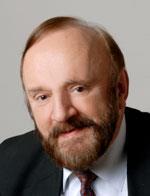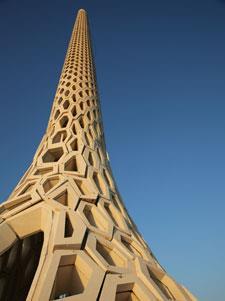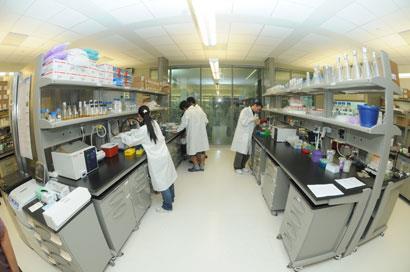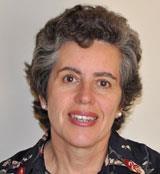Sarah Houlton speaks to research pioneers at the King Abdullah University of Science and Technology as it approaches its first anniversary
Sarah Houlton speaks to research pioneers at the King Abdullah University of Science and Technology as it approaches its first anniversary
A traditional university is arranged very much along departmental lines - chemistry, history, French, theology, whatever. Yet modern science is increasingly an interdisciplinary affair. So would it make sense for a new university to be arranged in an entirely different way - around research projects rather than subject-themed departments?


That’s the philosophy behind Kaust - the King Abdullah University of Science and Technology - in Saudi Arabia. The king himself has backed the project to the tune of tens of billions of dollars, and it went from first concept to opening for research in just 3 years - its official opening in September 2009 came less than 2 years after the foundation stone was laid.
The facility itself is impressive, having sprung up from almost nothing in the desert on the Red Sea coast, about 45 minutes from Jeddah. The campus covers 36km2, and as well as labs and classrooms there are houses and apartments, shopping malls and entertainment facilities. It’s a self-sufficient new town, built entirely for the university. Constructed by the Saudi Arabian Oil Company (also known as Saudi Aramco) with the help of a team of international architects and consultants, it’s a gleaming oasis of hi-tech buildings and state-of-the-art labs. As a research institution, its students are all on masters courses or doing PhDs and, unusually for the country, it is co-educational.
Starting from scratch
Chemist Jean Fr?chet has just been appointed from the University of California at Berkeley in the US as Kaust’s vice president of research, and is relishing the challenge of creating a world-class science and technology research institution from scratch. The way it is organised in research centres is key. ’University researchers will often pool their resources and knowledge to look at a new research area that requires interdisciplinary collaboration,’ he says. ’Here, we are starting with this multidisciplinary approach to look at specific problems. For example, in the Middle East there are issues with water, so one research centre focuses on water desalination and reuse. This will take chemists, biologists and engineers, and the structure brings all of these together into one entity.’
Another such area requiring a multidisciplinary approach is plant stress genomics. ’The idea is to look at plants that can grow in an environment that is very hot or very salty, and it’s common here to have both,’ says Fr?chet. ’The idea is to decipher the genome of the plants, and find out what makes them tick in these special environments. We have people in computation, others in pure biology - extracting genomes and characterising them - and others who are growing plants and modifying them genetically. We are right next to the Red Sea and this is virtually untapped in terms of what’s in there. In the first few explorations we found that if you go very deep there are extremely salty hot pools, and there are microorganisms in that hostile environment. We want to study these extremophiles, and see what we can do with them.’
Tremendous potential

The state-of-the-art buildings are backed by substantial funding to attract scientists from around the world. ’Both the financial resources and infrastructure are in place, and hopefully the results will start to flow,’ Fr?chet says. ’If you visit as a scientist, your eyes open wide as the potential is tremendous. We want to realise the potential by bringing in the right people, and then, of course, choosing the right students.
This takes a lot of work! My mission is to look after the research in terms of bringing new people in, but also look at the research directions we should focus on, making sure we start the right things in the right environment. It’s a challenge, but the excitement is very great and very motivating.’
The university is on a significant recruitment drive for academics. ’We are not working on this alone,’ he says. ’When you build a new university, of course no-one has heard of you, and we have done quite well at letting people know we exist. In large part, this was done by establishing relationships with top-notch institutions. In the UK, for example, we have partners at Imperial College London and the University of Cambridge that help us to seek out faculty, interview them, and bring them here. So in materials science, we have a contract with Imperial, where they advertise for positions, interview, and provide us with the people who would be their choices.’ Candidates then go over to Kaust to be interviewed, and see the place for themselves.
Not the traditional Saudi Arabia
Scientists are being recruited from all over the world, but Fr?chet says that in time the plan is to ensure increasing numbers of local people are trained and educated. ’Today, we have many professors from Europe, Asia and so on - it’s an extremely multinational place,’ Fr?chet says. ’The campus operates in English, and is a small town in itself. Many people have a slightly exaggerated impression of the country, but this is not the traditional Saudi Arabia, and it is providing us with quite remarkable means. For the longest time, Saudis have gone abroad for their education, so there are a lot of highly educated people, and while there are many universities here, very high level science and technology was only present in a very limited way. This is a new undertaking to try and change this.’

He describes the buildings as both beautiful and functional, and remarkably well equipped. ’The housing is first-rate and the facilities are outstanding - it’s clear they have spared no expense. The university was provided with a secure base of funding, which means we can bring faculty members here and assure them of support for their research - they will not depend on grant applications to be able to run their labs. We will simply guarantee support.’
In the longer term, renewal of an academic’s funding will be performance based, but they are in the happy position of having 5 years of support, without having to worry about scrabbling around for research funds. ’When we hire people, we guarantee them support. This doesn’t mean they won’t also write grant applications to supplement what they have from us and establish international collaborations - of course people will do that - but it does mean there is a very solid foundation where the university itself is acting as a funding agency. I am also in the very comfortable situation of knowing that if, for example, I want to start a new research centre, the funding will be there to build it and sustain it.’
Suzana Nunes
Brazilian national Suzana Nunes was one of the first cohort of academics who joined Kaust last September, coming from the GKSS Research Centre in Geesthacht, Germany, where she was head of the membranes for energy department. Her work is in the development of new polymers and nanocomposites for fuel cells and water treatment.

’I was in a very good centre in Germany, but what attracted me here was the chance to do things I could no longer do there,’ she says. ’The academic freedom is important - if you want to be innovative you need the freedom to choose the topics to work on. And the facilities here are excellent - the centre for microscopy is something you could only dream of in other institutions. But the most important point is the academic freedom. Another attraction was the chance to work more with students - I was supervising PhD students in a research centre before, but at the university there is a much more intense interaction with the students.’
’The campus is very big and has everything we need to live,’ Nunes explains. ’Like many of the other people here, I walk to work, and it is good that the community is so international. It’s also good to have contact here with so many women students - this is a big issue here and I’m happy to be able to contribute.’
Collaborations encouraged
Fr?chet is very aware that the researchers could become isolated, so international collaborations are encouraged. ’People may have joint grants funded by Kaust for their research, and also at their partner institution,’ he says. ’This will ensure a flow of scientists, with people coming here and our people going over to another country. We want to make sure our researchers have access to the best minds, that they have people to talk to, and their research is not insular.’
He believes it will take 5 years to reach a full complement of academics. ’We anticipate that when the university is working at full speed, we may have 200-250 faculty members, and at most about 2000 students,’ he says. ’This is not something we want to rush, as if we go too fast we may make mistakes! We want to operate carefully, bringing in maybe 35-40 people a year.’
The research areas will not stand still, either - there are plans to expand from nine to about 20 in the future. ’We aim to create "centres in waiting", with a small nucleus of people to see whether it really is the direction to go in,’ he says. ’Of course, we will fund them to a good level, and if they show they can develop well and contribute to our mission, we will develop a full-blown centre.’ For example, he says, the links between its catalysis, solar and membrane centres, all of which are related to polymers, might mean a centre for polymers would make a lot of sense.
Timothy Ravasi
Italian systems biologist Timothy Ravasi moved to Kaust from the University of California San Diego in the US, and is very excited about the opportunities available at the new institution. He focuses on marine animals - so Kaust, on the shores of the Red Sea, is an ideal location. ’The lab is just opposite the sea, so we can walk out to the sea, collect samples of sponge or coral, and be back in the lab within half an hour. That’s unusual!’
He moved out to Saudi Arabia just before the university opened last September, and as well as the accessibility of marine organisms, the financial side was very appealing. ’They give researchers a generous amount of money for 5 years to do research. When I was hired they asked what I needed for my lab, I gave them a list of machines I wanted, and they were bought,’ he says. But the real advantage, he believes, is the academic freedom the university affords him.

’It’s much easier to get a grant in the US on a hot topic like cancer than to study coral reefs. As marine organisms like corals don’t move, they need to protect themselves by producing bioactive models that can kill bacteria. We go into the sea, collect samples, do genomic analysis and test for bioactivity in human cells. For example we are screening molecules that may be important for malaria as they can kill Plasmodium parasites.’
This academic freedom is allowing him to move into the uncharted territory of genomic systems biology of marine invertebrates. ’I couldn’t have done this in the US as I wouldn’t have the money,’ he says. ’Here, I can.’
Commercialisation
Commercialising the university’s research has also been considered. ’We have built a large integrator, where we already have some start-up companies from professors and students,’ he says. Seed funding is available to facilitate these early stages. An industrial park is also being set up on the campus, where companies will be able to set up research facilities of their own. ’Sabic [the Saudi Arabian Basic Industries Corporation], for example, are establishing a facility, and we will be able to provide them with well-trained scientists,’ he says. ’Dow Chemical is also building a large facility here, and we have a long list of people who are knocking on our door. We don’t want to go too fast, and we’re not looking for production facilities - we are only interested in R&D.’
Fr?chet is excited at the prospect of developing this new model for research, and is optimistic that it will be a success. ’We’re not so concerned about saying, "my field is chemistry, and we’ll only do chemistry." It’s multidisciplinary to start with,’ he says. ’What excites me is creating an environment where we will go all the way from fundamental research to start-up company, and all of this with resources that are right here at our disposal.’
Sarah Houlton is a freelance science writer based in London, UK






No comments yet